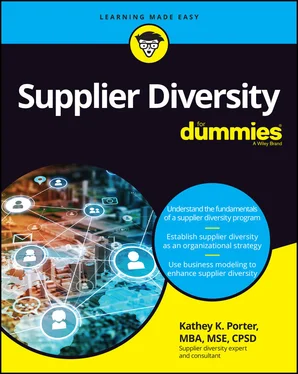Kathey K. Porter - Supplier Diversity For Dummies
Здесь есть возможность читать онлайн «Kathey K. Porter - Supplier Diversity For Dummies» — ознакомительный отрывок электронной книги совершенно бесплатно, а после прочтения отрывка купить полную версию. В некоторых случаях можно слушать аудио, скачать через торрент в формате fb2 и присутствует краткое содержание. Жанр: unrecognised, на английском языке. Описание произведения, (предисловие) а так же отзывы посетителей доступны на портале библиотеки ЛибКат.
- Название:Supplier Diversity For Dummies
- Автор:
- Жанр:
- Год:неизвестен
- ISBN:нет данных
- Рейтинг книги:4 / 5. Голосов: 1
-
Избранное:Добавить в избранное
- Отзывы:
-
Ваша оценка:
- 80
- 1
- 2
- 3
- 4
- 5
Supplier Diversity For Dummies: краткое содержание, описание и аннотация
Предлагаем к чтению аннотацию, описание, краткое содержание или предисловие (зависит от того, что написал сам автор книги «Supplier Diversity For Dummies»). Если вы не нашли необходимую информацию о книге — напишите в комментариях, мы постараемся отыскать её.
Supplier Diversity For Dummies,
Supplier Diversity For Dummies
Supplier Diversity For Dummies — читать онлайн ознакомительный отрывок
Ниже представлен текст книги, разбитый по страницам. Система сохранения места последней прочитанной страницы, позволяет с удобством читать онлайн бесплатно книгу «Supplier Diversity For Dummies», без необходимости каждый раз заново искать на чём Вы остановились. Поставьте закладку, и сможете в любой момент перейти на страницу, на которой закончили чтение.
Интервал:
Закладка:
Demographic shifts: The changing face of the majority
According to census figures, by 2042, racial minorities (those that identify as part of a race other than non-Hispanic, single-race whites) are poised to become the new majority, making up more than half the U.S. population. By 2050, 54 percent of the population will be minorities. In a country whose history has been shaped by the boundaries among racial groups, this projected demographic shift is undoubtedly important. Additionally, U.S. society is increasingly represented by a cross-section of generations, including seniors and millennials (typically defined as those born between 1981 and 1997).
But what does it mean for the supply chain? As diverse populations increase, so does their spending power and influence. Gone are the days when companies told you what to think, do, and buy with no questions asked. Today’s buyers are very savvy. They’re looking for connections to the brands they buy from, whether that connection is in the organization’s principles and beliefs or its leadership. These buyers want to know that organizations stand for something that makes society better. And if that’s something that they value and believe in, that’s even better.
Forrester, a leading consumer research and consulting firm, refers to them as the values-based consumer. Customers are becoming more aware of — and sensitive to — social issues and using this to make purchasing decisions.
Social activism/economic inclusion
Activism has always played a part in the causes agencies and corporations take on. Though internal stakeholders can champion a cause, true activism starts from the outside, usually in an area that people feel the organization isn’t supporting or being responsive enough to.
Supplier diversity got its start based on calls for economic inclusion within the Black community. It has expanded over the years to include women-, LGBTQ, and veteran-owned businesses. Because of their positions in the community — often as large employers and major economic engines — organizations are realizing they have the power (and a responsibility) to address economic disparities through their supply chains and how they purchase the goods and services needed to run their organizations. In addition to being responsive to the needs of the community, they’re finding that it also makes business sense.
Accountability to secondary stakeholders
Stakeholders are individuals or groups that have an interest in the organization and, whether directly or indirectly, are impacted by its actions. Stakeholders can be broken into two different groups: primary and secondary. Organizations have a different responsibility to each group.
Primary stakeholders are employees, suppliers, boards of directors, owners, shareholders, and customers. Secondary stakeholders are external groups such as government and regulatory agencies, trade and labor unions, political and social groups, the media, and so on. They drive supplier diversity in the external environment. In this age of cancel culture, they can wield tremendous influence, both positively and negatively, on the actions that the organization takes. They indirectly affect the organization by taking actions that either support the organization’s efforts or make success difficult.
In some communities, supplier diversity can be an emotional and highly charged subject. When I was a practitioner, usually once or twice a year, I’d get a call from a reporter wanting to know for an article how much we were spending with small and diverse businesses. It usually came after a politician announced “increasing opportunities for small and diverse businesses” as part of their platform.
This usually created a frenzy about who would respond and what exactly should be shared (going on the record can be tricky). If the results were good, it would be nothing more than an informative article. If the results weren’t so good, it usually created a firestorm in the community resulting in meetings with community leaders pushing for reforms for increased opportunities, an overhaul of the program, or even the removal of the supplier diversity leader. These stakeholders hold organizations accountable to their commitment to create opportunities for small and diverse businesses and push them when they feel their actions aren’t enough or results aren’t being achieved.
That’s how external stakeholders can drive change. Sometimes public outcry is needed before the organization takes action. Also, this interaction forms the basis for a long-term collaborative relationship. External stakeholders know what businesses in the community need. Internal stakeholders know what resources are available and how to navigate internally to get it done.
Recognizing Why Organizations Are Recommitting to Supplier Diversity
As the new law of the land, the diversity-related executive orders of the late 1960s and early 1970s were based on the government’s desire to do something to address systemic economic disparities within the Black community. (See Chapter 2for more on these orders.) Arguably, supplier diversity didn’t always live up to its expectations for any number of reasons, whether it was lack of total commitment by the organization; little or no compliance, oversight, and enforcement; or just the vagueness regarding exactly what to do. Today, society is still facing calls for change to address the same economic disparities.
But companies have a chance to get it right. Many organizations are doubling down on supplier diversity efforts and strengthening the commitment to developing impactful programs that focus on the whole system of supplier diversity management (SDM) and deliver on the promise of economic inclusion. The following sections explore a few of the internal reasons organizations are recommitting to supplier diversity.
Complex business challenges/strategic advantage
If there was a mantra for running a business, it would be “stay prepared for the unexpected.” So many elements are involved, and things can change at the drop of a hat. As markets move faster and grow increasingly complex, organizations are looking for efficiency and innovation in every aspect of the business, including their supply chain.
 Organizations are realizing that having a diverse supplier pool makes good business sense. The gains they can receive — whether through price competitiveness or access to industry expertise and know-how, not to mention the intrinsic value in community goodwill — are all things that provide organizations with the strategic advantage needed in order to remain competitive in the 21st century. Supplier diversity isn’t just the right thing to do but an economic imperative.
Organizations are realizing that having a diverse supplier pool makes good business sense. The gains they can receive — whether through price competitiveness or access to industry expertise and know-how, not to mention the intrinsic value in community goodwill — are all things that provide organizations with the strategic advantage needed in order to remain competitive in the 21st century. Supplier diversity isn’t just the right thing to do but an economic imperative.
Increased focus on collaboration in the supply chain
As interest increases in the supply chain, so does the interest in supplier diversity. Expanding market reach, greater customer focus, and increasing market and cost pressures are forcing many organizations to reevaluate the effectiveness of their supply chains. The disruption caused by the COVID-19 pandemic has also required supply chains to become more flexible and responsive than ever before. As many industries experience challenging transitions, supply chain partners are increasingly important to improve supply chain capabilities, efficiencies, and impact to the bottom line. As organizations become more dependent on their suppliers, collaborative planning becomes more central.
Читать дальшеИнтервал:
Закладка:
Похожие книги на «Supplier Diversity For Dummies»
Представляем Вашему вниманию похожие книги на «Supplier Diversity For Dummies» списком для выбора. Мы отобрали схожую по названию и смыслу литературу в надежде предоставить читателям больше вариантов отыскать новые, интересные, ещё непрочитанные произведения.
Обсуждение, отзывы о книге «Supplier Diversity For Dummies» и просто собственные мнения читателей. Оставьте ваши комментарии, напишите, что Вы думаете о произведении, его смысле или главных героях. Укажите что конкретно понравилось, а что нет, и почему Вы так считаете.












